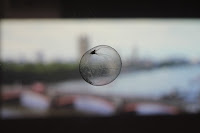
A membrane is essentially a selective barrier-cum-passage. Our skin is a membrane : it covers and demarks our physical entity like a protective case. At the same time, it allows us to absorb the outer world into our bodies. Its pores and cells provide us access to the atmosphere and one another in ways that make us feel connected to the environment around us. The Post-Glass Video Festival features some works that explore various surface techniques and layering processes to speak about the membranous qualities of glass.
Table by Betsy Dadd is stop frame animation that is generated from oil painting on glass. While thematically centered around acts at a table, the animation is just as much about the materiality of glass that allows mutating images on its surface. Glass, as a membrane that offers no texture of its own is the perfect substrate or canvas. The subjects in Dadd's paintings move and flow, meld and erase as the pigment slides on the smooth surface of glass. The work inspires unadulterated joy of an image being formed and dissolved at front of our eyes.
In Compound Focus, a series of video portraits shot through a slab of dapple-textured glass by Emma Hogarth, an interesting flip of technological sensibility occurs. She transfers the effect of a still camera to the context of a moving image. The result is a painterly effect in which the subjects move very slowly and the slight shifts in light are transmitted through the glass membrane cum lens cum filter.
Netta Bacon's Pack imparts the human hand a quality of glass by printing on transparent paper. This is merged with the appearance of the glass glove that is transparent in its materiality. By thinking of glass as a membrane, the artist captures the body within an object (glove) only to exceed its boundaries like a ghost. A single image, yet layered. In both, material and metaphorical play of transparency.
Kevin Kay uses the transparency of glass in a different manner: he plays with antiquated technologies. In Untitled, membranes of tracing paper, the glass of the TV monitor, the image being played and VCR feedback vary the level of opacity from the re-shot projection. By treating this range of glass-based or glass-like "materials" as membranes that allow other images to seep through their surfaces, he constructs a complex, layered, abstract image, a collage in flux.
BMB (can't say goodbye) by Armel Hostiou is unique in this festival for the way in which it shift the perception of glass' invisible hardness : as a one-way membrane, a secret limit that can be passed in one direction but not in the other. Hostiou uses glass, breath and water to speak of invisible barriers such as the emotion of feeling trapped, or more simply, time, as a filter for matters or actions one way but not backwards. This one-way membrane of glass weaves doubt between absence and presence to represent two states of mind, time or situation.
In contrast is The Opposite of Mitosis by Charlotte Potter, which explores the dynamic space of fusion where two fluid entities meet and meld together. Enacted through the coming together of the shadows of two molten glass bubbles, the work specifically deals with push-and-pull interactions at the common membrane. Viewed in a petridish on a steel table, the installation uses a choreographed membrane of glass to engage the psychological space of fusion, one that neither always identical nor regulated.
As seen above, post-glass artists are sensitive to the material and optical properties of glass that lend themselves to being treated as a membrane in many ways.

No comments:
Post a Comment